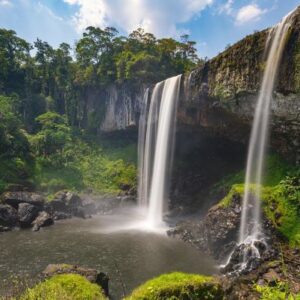The Central Highlands region of Vietnam is home to some of the country’s most stunning and majestic waterfalls. These natural wonders, nestled amidst lush forests and rugged mountains, offer visitors a chance to immerse themselves in the region’s captivating beauty. Let’s discover Vietnam and explore some of the most notable waterfalls in the Central Highlands.
Dray Sap waterfall (Dak Lak – Dak Nong)
Dray Sap Waterfall is located in Duc Lap Village, Dak Sor, Krong No district, Dak Nong province. This location is 39 km from the center of Buon Ma Thuot city, however, it is quite easy to find as it is the connecting point between the two provinces of Dak Lak and Dak Nong.
The waterfall has a height of around 20 meters but a width of up to 100 meters. The name “Dray Sap” means “smoke” in the E De language. This name alone can describe the grand and beautiful nature of this tourist destination.
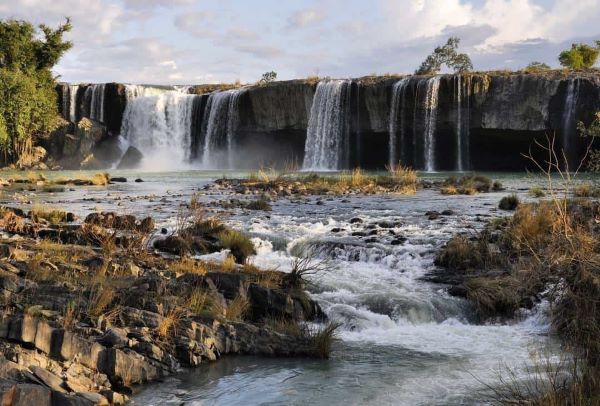
The mesmerizing beauty of Dray Sap Waterfall Vietnam
The best time to visit Dray Sap Waterfall is from December to March of the following year. During this season, there is beautiful sunshine, and the water is clear and emerald green, which is very impressive.
As a natural and pristine tourist destination in the Central Highlands, this place does not have many tourism services yet, so the entrance fee is quite affordable. You only need to spend 1.6 – 2.4 USD per person.
K50 Waterfall (Gia Lai)
K50 Waterfall (also known as Hang En Waterfall) is considered one of the most beautiful waterfalls in the Central Highlands region. It is located deep within the Kon Chu Rang Nature Reserve, in K’Bang district, Gia Lai province. The waterfall has been described as a white sash flowing through the pristine mountainous forest.
Tucked away in the sacred forest, the waterfall has been able to maintain its pristine and majestic beauty. The name “K50” is a reference to the waterfall’s height of over 50 meters. Behind the flowing water is a cave that is home to many swallows.
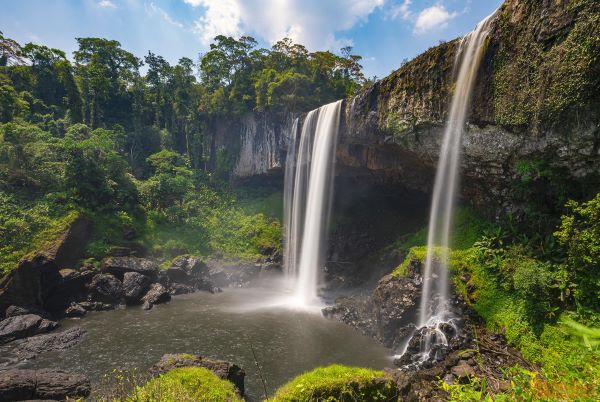
Magnificent beauty of Hang En Waterfall
The best season to explore the waterfall is the dry season from March to June each year. During this time, the weather is sunny with no rain, and the waterflow of the waterfall is gentler.
To reach Hang En Waterfall, visitors must go through a challenging journey of nearly two days trekking through the forest. Visitors should book a trekking tour to get the best experience.
Lieng Nung Waterfall (Dak Nong)
Located in Gia Nghia City, Dak Nong Province, Lieng Nung Waterfall, formed by the flow of Dak Nia Stream. The waterfall is famous for its pristine, majestic beauty, interwoven with a touch of dreaminess and romanticism of the primeval Central Highlands.
Lieng Nung is the only waterfall on the Dak Nia stream, originating from the sacred forests, so the water here is always crystal clear and flows white all year round. In the local language, “Lieng” means waterfall, and “Nung” means a resting place. Therefore, Lieng Nung means the waterfall where one can rest.
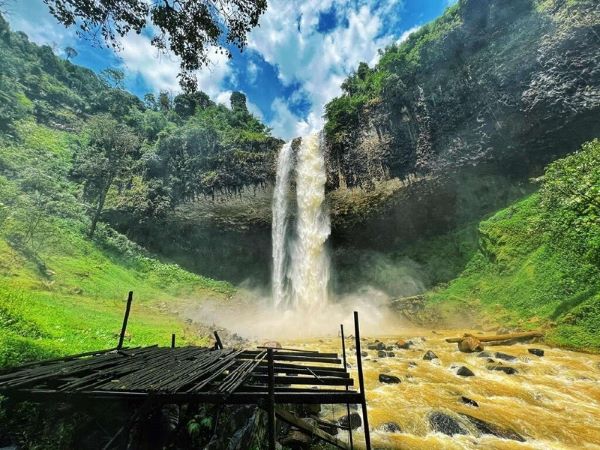
Pristine Lieng Nung Waterfall in Dak Nong Province, Central Highlands Vietnam
The climate around the waterfall is divided into two distinct seasons: the dry and the rainy season. If visitors want to admire the majestic cascading waterfall, they should visit during the rainy season from May to October. However, if they want to swim in the waterfall, the best time to go is during the dry season from November to April.
The way to Lieng Nung Waterfall is quite difficult. When you get close to the waterfall, you’ll have to leave your vehicle and walk about 300 meters. Although the journey is challenging, once you see the waterfall, all the fatigue seems to disappear, replaced by awe at the majestic beauty of Lieng Nung Waterfall.
Bao Dai Waterfall (Lam Dong)
One of the largest and most majestic waterfalls in Lam Dong is the Bao Dai Waterfall, a place that is not yet well-known to many tourists, but it possesses breathtaking beauty with remarkably unique landscapes.
The Waterfall is located in Ta Hine commune, Duc Trong district, about 70 km from Da Lat. Bao Dai Waterfall is also called Jraiblian, meaning the high rock waterfall and many people call it the”Neglected waterfall” for very few people who come here.
The waterfall has maintained its primeval character, with a rich and diverse vegetation. The path leading to the base of the waterfall winds through the hills, sometimes passing through narrow ravines between steep rocks.
The most ideal time to explore this place is from November to June next year. At this time, the sky is usually sunny and warm, with few storms, so it will be extremely favorable for tourists’ fun and exploration activities.
When you come here, you not only get to admire the majestic natural scenery, but you can also hear many legendary tales and historical stories about the waterfall. The area around the waterfall has long been the home of ethnic minority groups.
Siu Puong waterfall (Kon Tum)
Siu Puong Waterfall is located across the northern part of the Van Peo mountain range, within the territory of Dak Na Commune, Tu Mo Rong District, 89 km from the center of Kon Tum City.
This is a stunningly beautiful waterfall shrouded by pristine, ancient forests, exuding a primal and majestic charm. The waterfall is located at an elevation of 1,524 meters above sea level, with 5 main tiers and a total height of 204 meters from the base to the top, making it one of the highest waterfalls in Vietnam.
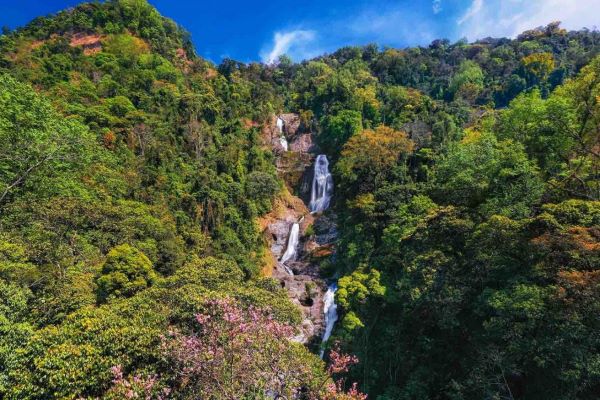
The waterfall flows in a very unique zigzag pattern
The most ideal time to admire the waterfall’s perfect beauty is around October, when the waterfall is supplied with abundant water from the upstream, and its surface can expand up to 30 meters, creating a breathtakingly magnificent scene.
To witness the beauty of the waterfall, visitors must pass winding and twisting roads. While the outer road can be accessed by motorcycle, there is a 2km forest trail that requires trekking. This experience of hiking through the forest and crossing streams will allow visitors to immerse themselves in the pristine scenery.
Pongour Waterfall
Located approximately 50 km from the center of Dalat City, the Pongour Waterfall is situated within Duc Trong District, Lam Dong Province. This is one of the most beautiful and majestic waterfalls in the Central Highlands Vietnam.
The waterfall cascades from a height of nearly 40 meters, stretching over 100 meters across a multi-tiered, stepped rock formation. The local people refer to it as the “7-Tiered Waterfall” due to the 7 distinct rock ledges that the water flows over. Surrounding the waterfall is a lush, diverse vegetation cover.
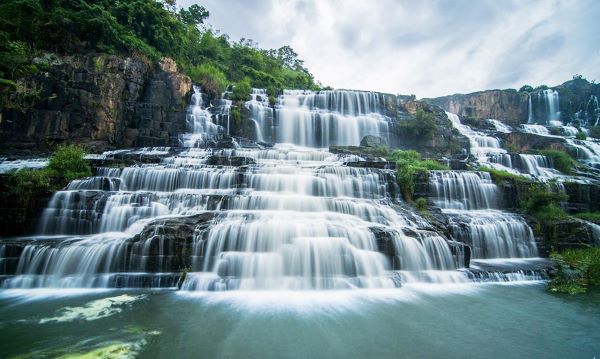
Pongour – a Stunning Terraced Waterfall in Central Highlands Vietnam
As visitors approach the Pongour Waterfall, they’re greeted by the sound of the rushing water echoing through the surrounding forests. Hiking trails and viewing platforms offer sample opportunities to admire the waterfall from various angles, showcasing its unique and captivating beauty.
If visiting the site in the rainy season between April and October, tourists can see water flowing down into a big pool. In the dry season, from November to March, travelers can see a breathtaking view of nature when wild sunflowers are in full bloom, turning the path leading to the waterfall into light yellow color.
These waterfalls in the Central Highlands of Vietnam are true natural gems, offering visitors a chance to immerse themselves in the region’s captivating landscapes and pristine environments. Whether you’re seeking a serene escape or an adrenaline-filled adventure, these waterfalls are sure to leave a lasting impression when traveling to Central Vietnam.
Read more:

